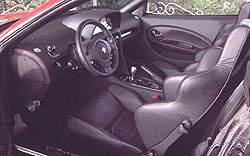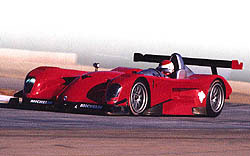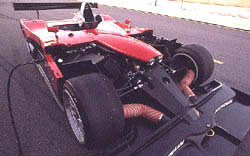|
|
|
Panoz Road & Race Cars Young American car manufacturer builds heritage with road car and Le Mans racer..It is early winter, about 40 degrees Fahrenheit at the Road Atlanta race circuit in Braselton, Georgia. Just before the front straight, a fast-approaching Batmobile-like Panoz LMP-1 Roadster S . dashes down the hill, pushing through the crisp, cold air with a deafening rumble. A split second later the same Le Mans racer thunders by with an ear-piercing crackling exhaust note at speeds in excess of 170 mph. Your heart pounds quickly and adrenaline rushes to the tips of your fingers and toes; any hint of cold in your body has all but vanished now The LMP-1 Roadster's stout on-track presence is indicative of the fierce commitment that Danny Panoz and his father Don share to produce American-built luxury grand touring road cars and professional sports racers. Yes, over the years there have been several small car manufacturers that over-promised and under-delivered. But none has fully immersed itself in the automotive enthusiasts' world with the same vigor and methodical approach as the Panoz family. Late in 1989 the younger Panoz started Panoz Auto Development and began building a cycle-fendered roadster. Underneath its skin was a stainless-steel space frame based on a design by the Irish small car builder Thompson Motor Company, and it was powered by Ford's 5.0-liter pushrod V-8. Six years later Panoz became the first modern American car manufacturer to use an aluminum chassis. The new Panoz A.I.V. (Aluminum Intensive Vehicle) Roadster was also fitted with an all-aluminum, 305-bhp 32-valve V-8 (see "Les 24 Heures du Madonna Inn," March 1999). Expanding into a more refined and exclusive high-performance market, the grand touring Esperante convertible was introduced in 2000 equipped with the Ford Mustang Cobra's 320-bhp V-8 (see the October 1999 issue). Catching a bit of his son's car enthusiast bug, the elder Panoz saw motorsports as a viable business venture and entered professional sports-car racing by starting Panoz Motor Sports in 1997. Since then, he has founded the American Le Mans Series (ALMS), complementing the famed Automobile Club de l'Ouest's 24 Hours of Le Mans. He also purchased Road Atlanta Motorsports Center and Sebring International Raceway to help establish stability and promote sports-car racing in the United States, along with Mosport Park Raceway in Canada. Even though the Panoz father-and-son team is considered a newcomer to the automotive scene, both men quickly earned respect in the industry with their keen business sense, building competent road cars and winning race cars in just a few years. The Esperante is a powerful, dynamically balanced GT, and the Panoz LMP racers have won many important competitions worldwide against the big guys like Audi and BMW. Esperante Magnussen Edition Road Car Begining this year, Panoz Auto Development is planning to build a limited number of Esperante Driver's Editions, celebrating its successes in sports-car racing with winning drivers Jan Magnussen and David Brabham. There will be 10 special Esperantes built per year per driver. Fortunately for us, Danny Panoz offered up the factory's first Esperante fitted with Magnussen's personal touches for a test drive in Seattle, Washington. Based on a bonded and bolted, multi-celled aluminum space-frame chassis, the 2002 standard Esperante and the Magnussen Edition go a step further by incorporating carbon-fiber composites in the main cockpit structure and trunk. This preformed Firewall/Bulkhead/A-pillar (FBA) assembly is a monocoque-like tub for the passenger cabin similar to those used in race cars and helps the chassis to achieve an impressive rigidity of 7400 ft.-lb. per degree of rotation
Extending out from the chassis, the front's upper and lower A-arm suspension is located off a steel subframe that also cradles the engine. At the rear, another steel subframe holds the fuel cell. It too serves as a mounting point for the rear's double A-arm suspension taken from the Mustang Cobra. Panoz engineers designed their own tighter-packaged horizontally opposed coil-over shocks acting through rockers and pushrods. The rocker geometry simulates a rising-rate suspension allowing better compliance under normal use and more aggressive settings for sportier driving. Magnussen's suspension specifications call for stiffer spring rates and different rear rockers to make the car handle more like his race car, but not compromising too much on everyday driveability. Upgraded Michelin Pilot Sport A/S tires, 245/40ZR-18s front and 275/40ZR-18s rear, mounted on BBS LM wheels with a better brake and rotor package are also on the list of improvements for the Driver's Edition. On the outside are sleek, Magnussen Red (almost a metallic burgundy) superformed aluminum body panels (manufactured with the same techniques as those used on Boeing aircraft). More carbon-fiber components such as the front chin spoiler, side engine vents and the trunklid's rear lip give the car a high-tech racy look. Inside, the leather-wrapped instrument panel and center console are also furnished with glossy carbon-fiber composite accents complementing the billet alloy pedals and shifter. Lighter and more supportive seats are standard on this Esperante Driver's Edition. According to Panoz, the overall weight savings with the extensive use of carbon-fiber components on the Magnussen Esperante are about 130 lb. So the same 4.6-liter, 320-bhp and 317 lb.-ft. of torque V-8 combined with tighter suspension setup should propel the Driver's Edition off the line a little quicker and provide better cornering ability than the standard model. Unfortunately, Mother Nature never cooperated for any instrumented testing while we were in Seattle. But despite the gloomy and damp weather we still were able to gain valuable on-road impressions and toss the Esperante Magnussen Edition around a bit at Bremerton Raceway, Washington. In the data panel you will find the test results from the standard 2000 Panoz Esperante. Compared with the standard model, the Magnussen Edition rides stiffer on the highway, but not so much to make it uncomfortable for two- to three-hour stints on the Interstate. Surprisingly, top-down cruising at higher speeds generates very little buffeting inside the cockpit, so holding a normal conversation is not a problem. The noise that does come through, however, is a welcome low rumble from the good-ol'-American V-8. With help from its precise and short-throw 5-speed manual transmission, this Georgia-built muscle car can speed past slower traffic quickly with its addicting, broad powerband. Of note, the heater was fantastic and worked flawlessly in keeping us warm while the outside temperature hovered near freezing levels. Through winding roads in Washington state, the Magnussen Edition's steering feels positive and robust, with an appropriate amount of assist and effort. The car's 50/50 weight distribution lets the front wheels do the guiding and keeps its rear in check with ease. Only mild understeer is detected through slower corners. At Bremerton Raceway, which is basically an unused airport, an impromptu racetrack is set up by connecting a series of taxiways. The Magnussen corners with modest roll but confidently grips the concrete and asphalt surfaces. Power-on oversteer is easily induced. However, oversteer can also be corrected with throttle modulation and countersteer. Push the car around a long, sweeping corner and it drifts nicely on all four tires as you feed in more power. Simply put, the Esperante Magnussen Edition is a delight to drive. Admittedly, with a sticker price starting at $116,765, there are other high-performance GTs wearing better-known badges. But if you are looking for an American exotic that comes with personal attention and exclusivity, give Danny Panoz a call. Hey, even Enzo Ferrari was unknown at the beginning
LMP-1 Roadster S Le Mans Racer Back in Georgia and in the pits of Road Atlanta, IMSA Champion and Road & Track's hot shoe Steve Millen and I are waiting for our turn to pilot the purpose-built LMP-1 Roadster S Le Mans racer. Thanks to Panoz Motor Sports team manager Andy Waldrep, we are able to slot in our drives during the LMP's brake testing. For Millen the professional, commanding a lightning-quick sports car around the track is familiar. But for me the civilian, I am excited and intimidated at the same time to have a 600-bhp, 2100-lb. demon under my control (I hope!). Panoz's front-engine, rear-drive race car drew its share of skeptics when introduced in 1997. Its engine location ran against the conventional mid-engine layout in the top level of professional sports-car racing. But by 1999, the Panoz formula did work. It proved to be successful in marketing itself worldwide, and the LMP-1 Roadster S won the American Le Mans Series Team and Manufacturer's Championships that year. For this year, Panoz Motor Sports is bringing back the LMP-1 to compete in ALMS and also at the 24 Hours of Le Mans. Jan Magnussen and David Brabham will be joined by CART driver Bryan Herta and reigning ALMS GTS Champion Terry Borcheller. The heart and soul of the LMP-1 Roadster S is a Ford Motorsports V-8 powerplant heavily modified by Panoz engineers. Equipped with a Zytek Cross-Ram fuel injection system, the engine is capable of pumping out 600 bhp and 500 lb.-ft. of torque, pulling the carbon-fiber monocoque racer to a top speed of 180 mph at the end of Road Atlanta's back straight. And what distinguishes the LMP-1 from the others is the engine's raucously thunderous rumble that lets the fans know the Panoz is now on the track. According to Panoz Motor Sports engineer Sirish Vissa, using the same gearing for Road Atlanta, the Xtrac 6-speed sequential transmission helps launch the LMP from a standstill to 60 mph in just 2.3 seconds and to the quarter-mile marker in 9.3 sec. at 148.0 mph. Armed with 15-in. front and rear AP 6-pot carbon-on-carbon brakes, the Le Mans racer's stopping prowess is guaranteed to rattle your brain and bring on a serious headache. At operating temperature, the LMP's brakes can bring the car to a complete halt from 60 mph in 108 ft., and from 80 mph in 161 ft. After lunch, Millen takes his turn behind the wheel of the LMP Roadster. (See his driving impressions in the sidebar above.) To prepare for my ride, I had the opportunity to lap and familiarize myself with the track in a Panoz Auto Development Esperante GTS just the day prior. The GTS is a $59,695 steel tubular-frame spec racer powered by Ford Motorsport's 5.8-liter 385-bhp V-8 and it is intended for racing in Sports Car Club of America events. So feeling at least comfortable with the track, I settle into the LMP cockpit. The crew helps to make sure the safety harness is securely buckled, and the race engineer explains what all the buttons, switches and instrumentation mean. "Just remember which ones will start and shut off the car," I say to myself. Millen's advice to warm up the brakes by lightly depressing the pedal while running, and not to push too hard on cold, slick racing tires on the first lap played repeatedly in my mind. My first priority, however, is not to stall the car leaving the pits. Thumbs up to the crew and the car is lowered quickly from its air jacks. Wow. Wow. And Wow! Clutch in and flip the starter switch. The LMP comes alive with a roar. I ease out the clutch and extend my foot into the gas pedal. And guess what, I stalled the car. I am sure that the entire Panoz Motor Sports team is thinking: "What have we gotten ourselves into?" My second attempt at getting the LMP rolling is a success, albeit with the engine coughing and sputtering a bit as I exit the pit lane. Driving the LMP is like no other car I have ever experienced. The amount of power available is immense. I have been in quick production cars like the Dodge Viper and Porsche GT2 that offer incredible off-the-line acceleration in 1st gear, but the Panoz LMP-1 pulls just as strongly in 2nd, 3rd, 4th, 5th and 6th! I can't feel where the powerband tapers off! The gearbox's no-lift feature is impressive, allowing for continuous upshifts as long as the throttle is pegged to the floor. Just pull back on the shifter and you keep rocketing away without the slightest interruption of power. On the back straight of Road Atlanta, I hold the steering wheel steady and let the LMP stretch its legs. I really don't know how fast I am going. My eyes are too busy focusing on the road ahead. However, what I can see through my peripheral vision is a blur of trees alongside the track, and what I can feel is the air rushing over the top of my helmet and wanting to lift me out of the seat. And the sound of the engine rumbling mixed with the air whistling around the cockpit is some of the sweetest music I have ever heard. Before Turn 10, far ahead of the braking zone, I tap the brakes. And even though I probably used only 50 percent of the brakes' capabilities, I can already feel the safety harness press against my chest as I am thrown forward as the LMP decelerates. Downshifting through the gears before a turn can be accomplished quickly by pushing the shifter forward and releasing as you blip the throttle. No clutch is necessary here.
My pace through the corners picks up a bit on the second lap. This I know because I can start to feel the enormous lateral grip that the LMP can generate with smooth but quick steering input. This Le Mans racer executes every steering command with utmost stability. At my slower-than-the-professional pace, the car feels very neutral, showing absolutely no hint of oversteer or understeer. Needless to say, I am not about to find out the cornering limits of the LMP-1. After a few laps, I pull into the pits. I flip the engine shutoff switch and the air jacks lift the LMP up. I climb out of the car with a big smile stretching from ear to ear. What a thrill ride! It is probably at least an hour later before my heartbeat finally settles back into any measurable scale. To an enthusiast like me, perhaps already driving faster than my skills warrant, the Panoz LMP-1 is surprisingly easy to drive. It is a kick-in-the-pants ride that I will never forget. Finally, I can understand what Jan Magnussen means when he says that a road car is not as interesting to drive after having been in the LMP Roadster. So the next step for the Panoz Esperante Magnussen Edition is to bring it closer in horsepower and handling dynamics to the Le Mans racer. One can only hope. I've raced different GTP cars at Daytona, Le Mans, Road Atlanta, etc., with me positioned between the front wheels and the rear engine, but never one with the power unit mounted up front and me sitting over the rear wheels. However, driving the Panoz LMP-1 did remind me of the twin-turbo GTS Nissan 300ZX I raced for the last seven years of my professional career. The main difference with the LMP is the open cockpit and the length of the hood. Never in my 25 years of racing have I ever had the front part of a race car extend out as far as the Panoz's. Steve Millen Drives the Panoz LMP-1 at Road Atlanta After adjusting to the aft driving position, I find the only real problem is my forward view. Approaching a blind corner from a lower elevation like Turn 2 at Road Atlanta, I have difficulty seeing the apex and placing the front wheels. On the other hand, I think this would become second nature with a tailor-made seat plus a couple of dozen laps. The LMP's 6.0-liter V-8 pushrod engine breathes through two 31.1-mm mandated air restrictors, which means it has been tuned to pull strongly at lower rpm. Third gear can be used in moderately tight 90-degree corners to prevent excessive wheelspin. The electrically operated power steering can be set to five different levels of assist, which is helpful for different tracks and long 12- and 24-hour races. For speed and good feel of the chassis, I prefer position three on the Panoz's power-assist dial. Formula 1-style carbon brake rotors and pads mean they need to be really hot to be effective. No power assist here; you get a better feel with a firm, hard pedal. With no traction control and little aerodynamic help in slow corners, 1st and 2nd gear in the LMP require very prudent use of the 'loud pedal.' Because of the large amount of torque available from the powerful engine, it is very easy to induce understeer into the corner and oversteer plus wheelspin on exit. At higher speeds, the Panoz is very well balanced and aerodynamically nailed to the road. Road Atlanta is a fast racetrack with significant elevation changes and blind corners. It makes for a very physically demanding experience. The Panoz LMP's blistering pace carried from Turn 1 through Turn 6 can take your breath away and cause your stomach to knot. There is little rest during a lap at this track. By the time you reach 6th gear at speeds over 180 mph on the back straight, you are instantly into heavy braking at the 100-yard marker, being thrown forward and steering into a tight 90-degree 2nd-gear Turn 10. It has been seven years since my last professional race and I had forgotten the physical demands of driving a fast sports car like the LMP at Road Atlanta. It reminds me of the time a television commentator asked a group of sports-car drivers what one word would describe the driving experience of a powerful race car on a road course. The most popular word was 'violent.' — Steve Millen.. By Patrick Hong Photos by Guy Spangenberg
|
|
Home < Panoz < Panoz Cars
|





